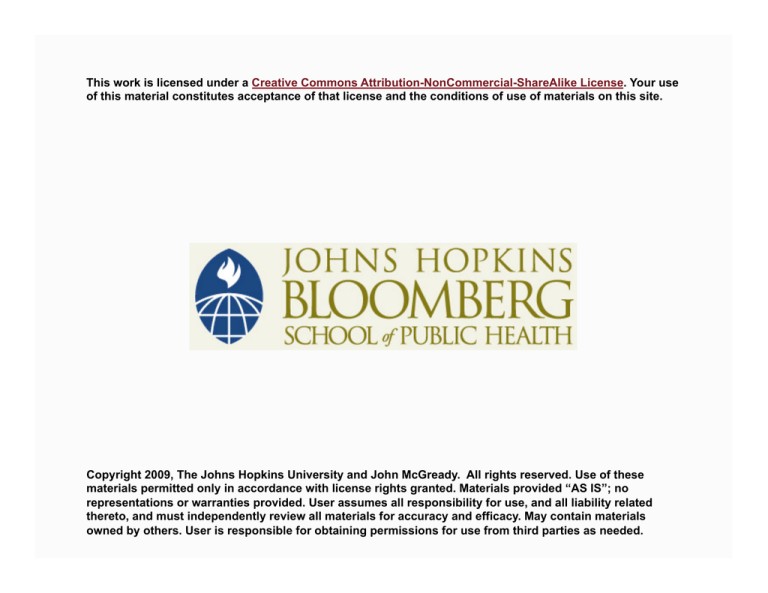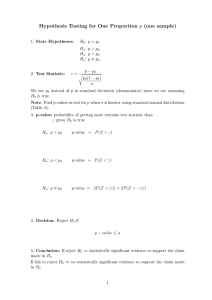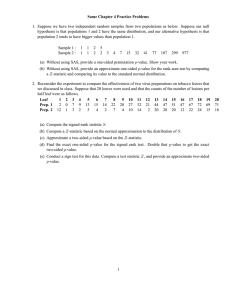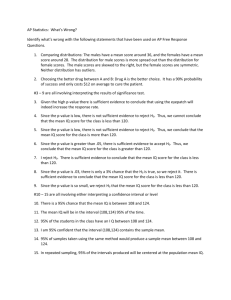
This work is licensed under a Creative Commons Attribution-NonCommercial-ShareAlike License. Your use
of this material constitutes acceptance of that license and the conditions of use of materials on this site.
Copyright 2009, The Johns Hopkins University and John McGready. All rights reserved. Use of these
materials permitted only in accordance with license rights granted. Materials provided “AS IS”; no
representations or warranties provided. User assumes all responsibility for use, and all liability related
thereto, and must independently review all materials for accuracy and efficacy. May contain materials
owned by others. User is responsible for obtaining permissions for use from third parties as needed.
Section D
The p-Value in Even More Detail!
p-Values
p-values are probabilities (numbers between 0 and 1)
Small p-values mean that the sample results are unlikely when the
null is true
The p-value is the probability of obtaining a result as extreme or
more extreme than you did by chance alone assuming the null
hypothesis H0 is true
- How likely your sample result (and other result less likely) are if
null is true
3
p-Values
The p-value is not the probability that the null hypothesis is true!
The p-value alone imparts no information about scientific/
substantive content in result of a study
Example: from Example 3, the researchers found a statistically
significant (p=0.005!) difference in average LDL cholesterol levels in
men who had been on a diet including corn flakes versus the same
men on a diet including oat bran cereal
- Which diet showed lower average LDL levels?
- How much was the difference; does it mean anything
nutritionally?
4
p-Values
If the p-value is small either a very rare event occurred and
- H0 is true
or
-
H0 is false
Type I error
- Claim HA is true when in fact H0 is true
- The probability of making a Type I error is called the
alpha-level (α-level) or significance level
5
Note on the p-Value and the Alpha-Level
If the p-value is less then some pre-determined cutoff (e.g., .05),
the result is called statistically significant
This cutoff is the α-level
- α-level is the probability of a type I error
- It is the probability of falsely rejecting H0 when H0 true
Idea: to keep the chance of “making a mistake” when the H0 is true
low and only reject if the sample result is “unlikely”
- Unlikeliness threshold is determined by α-level
6
Note on the p-Value and the Alpha-Level
Truth versus decision made by hypothesis testing
TRUTH
Ho
Reject Ho
HA
Type I Error
Power
alpha-level
1-beta
Not
Type II Error
Reject Ho
beta
7
Note on the p-Value and the Alpha-Level
Truth versus decision made by hypothesis testing
TRUTH
Ho
Reject Ho
HA
Type I Error
Power
alpha-level
1-beta
Not
Type II Error
Reject Ho
beta
8
Note on the p-Value and the Alpha-Level
Truth versus decision made by hypothesis testing
TRUTH
Ho
Reject Ho
HA
Type I Error
Power
alpha-level
1-beta
Not
Type II Error
Reject Ho
beta
9
Note on the p-Value and the Alpha-Level
Truth versus decision made by hypothesis testing
TRUTH
Ho
Reject Ho
HA
Type I Error
Power
alpha-level
1-beta
Not
Type II Error
Reject Ho
beta
10
More on p-Value: One-Sided vs. Two-Sided Controversy
Two-sided p-value (BP/OC: p = .009)
- Probability of a result as or more extreme than observed (either
positive or negative)
One-sided p-value
- Probability of a more extreme positive result than observed or a
more extreme negative result: only considers extremes in one
direction of null when evaluation how likely your sample result
is (and results less likely)
- If the direction of the alternative hypothesis in the one-sided
test is the same as the direction of the sample result in terms
of above/below the null, then the one-sided p-value with be
half the two-sided p-value
11
Stata Output
One-sided alternative: true mean difference >0
- Sample mean difference was greater than 0
12
Stata Output
One-sided alternative: true mean difference <0
- Sample mean difference was greater than 0
13
More on the p-Value
In some cases, a one-sided alternative may not make scientific
sense
- In the absence of pre-existing information, in evaluating the
BP/OC relationship, wouldn’t either result be interesting and
useful? (i.e., negative or positive association?)
In some cases, a one-sided alternative often makes scientific sense
- For example: not really interested if new treatment is worse
than old treatment—only care whether it’s better
However: because of “culture of p-value” and sanctity of “.05,”
one-sided p-values are viewed with suspicion
In this course, we will use two-sided p-values exclusively
14
Connection: Hypothesis Testing and CIs
The confidence interval gives plausible values for the population
parameter
- “Data take me to the truth”
Hypothesis testing postulates two choice for the population
parameter
- “Here are two possibilities for the truth; data help me choose
one”
15
95% Confidence Interval
If 0 is not in the 95% CI, then we would reject H0 that µ = 0 at level
α = .05 (the p-value < .05)
Why?
With confidence interval we start at sample mean difference and go
two standard errors in either direction (or slightly more in small
samples)
16
95% Confidence Interval
If 0 is not in the 95% CI, then we would reject H0 that µ = 0 at level
α = .05 (the p-value < .05)
Why?
With confidence interval we start at sample mean difference and go
two standard errors in either direction (or slightly more in small
samples)
17
95% Confidence Interval
If 0 is not in the 95% CI, then this must mean
errors away from 0 (either above or below)
is > 2 standard
Hence, the distance (t) will be > 2 or < -2: and the resulting p-value
<.05
18
95% Confidence Interval and p-Value
In the BP/OC example, the 95% confidence interval tells us that the
p-value is less than .05, but it doesn’t tell us that it is p = .009
The confidence interval and the p-value are complementary
However, you can’t get the exact p-value from just looking at a
confidence interval, and you can’t get a sense of the scientific/
substantive significance of your study results by looking at a p-value
19
More on the p-Value
Statistical significance does not imply/prove causation
For example: in the blood pressure/oral contraceptives example,
there could be other factors that could explain the change in blood
pressure
A significant p-value is only ruling out random sampling (chance) as
the explanation
Need a comparison group to better establish causality
- Self-selected (may be okay)
- Randomized (better)
20
More on the p-Value
Statistical significance is not the same as scientific significance
Hypothetical example: blood pressure and oral contraceptives:
- Suppose:
n = 100,000;
= .03 mmHg; s = 4.6 mmHg
p-value = .04
Big n can sometimes produce a small p-value, even though the
magnitude of the effect is very small (not scientifically/
substantively significant)
Very important
- Always report a confidence interval
- 95% CI: 0.002–0.058 mmHg
21
More on the p-Value
Lack of statistical significance is not the same as lack of scientific
significance
- Must evaluate in context of study, sample size
Small n can sometimes produce a non-significant even though the
magnitude of the association at the population level is real and
important (our study just can’t detect it)
Low power in small sample studies makes not rejecting hard to
interpret
Sometimes small studies are designed without power in mind just to
generate preliminary data
22









